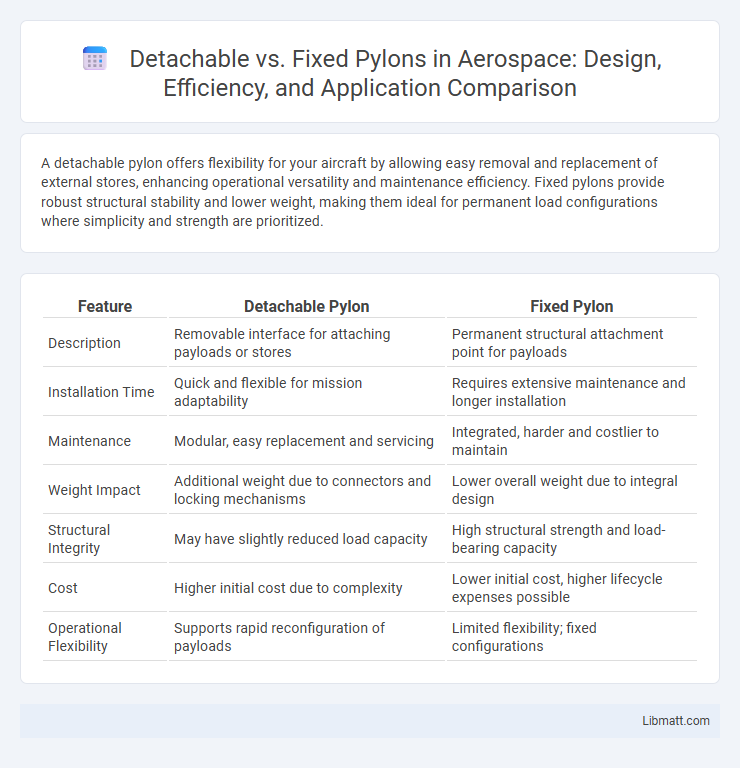A detachable pylon offers flexibility for your aircraft by allowing easy removal and replacement of external stores, enhancing operational versatility and maintenance efficiency. Fixed pylons provide robust structural stability and lower weight, making them ideal for permanent load configurations where simplicity and strength are prioritized.
Table of Comparison
| Feature | Detachable Pylon | Fixed Pylon |
|---|---|---|
| Description | Removable interface for attaching payloads or stores | Permanent structural attachment point for payloads |
| Installation Time | Quick and flexible for mission adaptability | Requires extensive maintenance and longer installation |
| Maintenance | Modular, easy replacement and servicing | Integrated, harder and costlier to maintain |
| Weight Impact | Additional weight due to connectors and locking mechanisms | Lower overall weight due to integral design |
| Structural Integrity | May have slightly reduced load capacity | High structural strength and load-bearing capacity |
| Cost | Higher initial cost due to complexity | Lower initial cost, higher lifecycle expenses possible |
| Operational Flexibility | Supports rapid reconfiguration of payloads | Limited flexibility; fixed configurations |
Introduction to Pylons in Prosthetics
Pylons in prosthetics serve as critical structural components connecting the prosthetic socket to the foot or terminal device, providing stability and support during movement. Detachable pylons offer modularity and easy replacement, enhancing customization and maintenance for users, while fixed pylons provide a rigid, integrated connection that may improve durability and alignment precision. Understanding the functional differences between detachable and fixed pylons informs prosthetists and users in selecting the optimal design based on activity level, comfort, and adjustment needs.
What Is a Detachable Pylon?
A detachable pylon is a modular component designed to easily connect and disconnect accessories or equipment, offering enhanced flexibility and convenience over fixed pylons. Unlike fixed pylons, which are permanently mounted and limit adaptability, detachable pylons provide users with the ability to quickly swap or remove attachments without specialized tools. If you require frequent changes or maintenance for your setup, a detachable pylon optimizes operational efficiency and simplifies customization.
What Is a Fixed Pylon?
A fixed pylon is a type of mounting structure permanently attached to an aircraft wing or fuselage, designed to carry external loads such as weapons, fuel tanks, or sensors. Unlike detachable pylons, fixed pylons offer increased structural integrity and reduced aerodynamic drag due to their seamless integration with the airframe. These pylons are commonly used on military and commercial aircraft where durability and performance are critical.
Key Functional Differences
Detachable pylons offer enhanced flexibility by allowing quick removal and replacement, making them ideal for maintenance and transport efficiency. Fixed pylons provide superior structural stability and load-bearing capacity, ensuring consistent performance under heavy or variable loads. Your choice depends on whether ease of adjustment or maximum strength is the priority in your application.
Advantages of Detachable Pylons
Detachable pylons offer significant advantages in flexibility and ease of maintenance compared to fixed pylons. You can quickly remove or replace the detachable pylon without extensive structural work, reducing downtime and labor costs. This adaptability is especially beneficial in applications requiring frequent modifications or inspections.
Benefits of Fixed Pylons
Fixed pylons offer enhanced structural stability and durability, making them ideal for heavy-duty applications and long-term installations. Their solid construction minimizes vibrations and movement, ensuring improved safety and consistent performance. You benefit from reduced maintenance costs and increased reliability when choosing fixed pylons over detachable options.
Suitability for Different Patient Needs
Detachable pylons offer increased versatility and customization, making them suitable for patients requiring adaptable prosthetic solutions that accommodate changes in limb volume or activity levels. Fixed pylons provide enhanced stability and durability, ideal for patients with consistent limb conditions who prioritize long-term reliability and weight-bearing capacity. Selection depends on individual patient needs, including residual limb shape, lifestyle demands, and frequency of prosthetic adjustments.
Durability and Maintenance Comparison
Detachable pylons offer enhanced maintenance flexibility through easier access for inspections, repairs, and replacements, reducing downtime and long-term operational costs. Fixed pylons provide superior structural durability due to their permanent attachment, ensuring robust stability under heavy loads and extreme weather conditions. However, fixed pylons may require more extensive maintenance procedures, increasing labor and equipment expenses over their lifespan.
Cost Considerations
Detachable pylons typically incur higher upfront costs due to their complex design and added mechanisms for easy removal and reinstallation, impacting your initial budget significantly. Fixed pylons offer a cost-effective alternative with lower manufacturing and maintenance expenses, making them preferable for projects with strict budget constraints. Evaluating long-term cost implications, including installation, maintenance, and potential replacement expenses, is crucial when choosing between detachable and fixed pylons.
Future Trends in Pylon Technology
Future trends in pylon technology emphasize lighter, more durable materials and enhanced modular designs, making detachable pylons increasingly popular for their ease of maintenance and upgrade flexibility. Fixed pylons still provide superior structural integrity for heavy-duty applications but may face limitations as adaptive airframe technologies evolve. Your choice between detachable and fixed pylons will depend on advancing requirements for aircraft performance, cost efficiency, and operational adaptability.
Detachable pylon vs Fixed pylon Infographic

 libmatt.com
libmatt.com